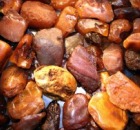




Records of Amber in Ancient History
Amber has been popular among writers since the B.C. era, so here are some of the most important records concerning amber in Ancient History.
The earliest written record dates from 883 B.C. and was discovered in the geographical zone of Egypt, in obelisk stone carvings. It states that Ashur-Nasir-Apal, an Assyrian ruler, sent his country’s people to “the land of amber”, a land where seas wash the amber shores “like copper”. The inscription is found in the British Museum.
Amber in Religion
History of Amber in Religion. It may seem hard to believe, but amber has an interesting history and a tale worth telling from generation to generation.
Amber Route
In ancient times, the boat was the main form of transportation and most of the trading routes ran along major river banks. The 5th century river routes linked Mediterranean countries and the Baltic coast. As people began to realize amber’s value, they started to trade with it. In some ways, amber became the gateway of improved commercial relations between countries and cultures. It also advanced international economic relations.
Superstitious Beliefs about Baltic Amber
Baltic amber is considered to be the world’s finest amber, and because people believed it had magical powers, it is only natural that superstitious beliefs developed. Even our ancestral mothers believed that healing amber had special connections with women. Following is a series of superstitions believed by people back in the days.
Chemistry of Baltic Amber
As with many other semi-precious stones, Amber is the result of nature’s power - millions of years of constant change and a process that we can refer to as amber chemistry. Amber is the result of tree resin and residual life forms such as plants, insects and small tree pieces that were buried underground or underwater for over 50 million years.
Amber in Arts
Amber is an extremely flexible stone, so many jewelers and craftsmen have tried to combine amber and art in their creations. Not everyone can create art using amber, due to the fact that it is a challenging stone, requiring creativity, imagination and dedication.
ea just to search for amber.
The Amber Industry in Lithuania
History of Amber industry in Lithuania Amber has been around on this earth for millions and millions of years, and we know that it is one of the world’s most fascinating semi-precious stones, with a long historical background.
Amber Use in Medicine
Amber is used not only in the jewelry industry, but also in others. Doctors recommend it as a natural antibiotic and anti-inflammatory treatment. Baltic amber is attested in historical reports since prehistoric times. Since then, it has been used in various ways. For example, in Ancient times, small amber pieces were placed under the Egyptian mummies’ skin to protect the dead from decay and destruction.
Succinic Acid and Baltic Amber in Modern Science
Succinic acid is a natural constituent of organic tissue. It is also known as amber acid, mainly because Baltic amber contains up to 8% of it in its surface and it is the only type of amber with such high concentration.
Amber as Traditional Remedy
People have been using amber in aroma therapies and rituals to cure diseases and epidemics since ancient times. It is not only a gem, but also a healing stone used to calm certain areas of the human body where pain is present. The easiest way to use amber as a traditional remedy is to wear it in direct contact with the skin. People used to place it in the area of the stomach, the spleen, the liver, the kidneys or any other internal organ where they felt pain or discomfort.













